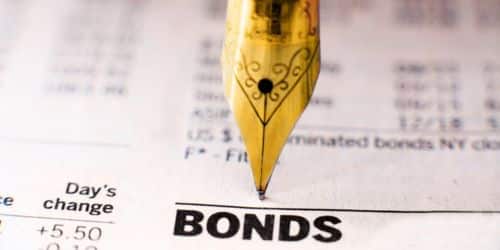Bonds are often purchased from a bond broker via full-service or discount brokerage channels, in the same manner that stocks are purchased from a stockbroker. While the availability of Internet brokerage services has reduced investment fees, engaging with a bond broker can still be prohibitively expensive for certain retail investors. Here’s a breakdown of how you can buy bonds, including available platforms like Robinhood and E-Trade.
How to Buy Corporate Bonds
Many specialized bond brokerages need large initial deposits; $5,000 is common. Account maintenance fees may also apply. And, of course, trade commissions. Broker commissions can range from 0.5% to 2%, depending on the amount and type of bond acquired.
When you use a broker (even your regular one) to buy bonds, you may be told that the transaction is commission-free. However, it is common for the price to be marked up so that the cost you are paying practically includes a compensation fee. If the broker does not profit from the transaction, they are unlikely to provide the service.
Assume you made an order for ten corporate bonds at a price of $1,025 per bond. You’d be told, though, that they cost $1,035.25 each bond, making your total investment $10,352.50 rather than $10,250. The difference amounts to a 1% commission for the broker.
Look up the most recent bond quote to ascertain the markup before purchasing; you can also utilize the Trade Reporting and Compliance Engine (TRACE), which displays all over-the-counter (OTC) transactions in the secondary bond market. Use your judgment to determine whether the commission fee is excessive or one that you are willing to accept.
How to Buy Government Bonds
Buying government bonds, such as Treasuries in the United States or Canada Savings Bonds in Canada, works slightly differently from purchasing business or municipal bonds. Many financial institutions provide their clients with the option of purchasing government bonds through their regular investment accounts. If you are unable to obtain this service through your bank or brokerage, you may purchase these securities directly from the government.
Treasury bonds and bills (T-bonds and T-bills) can be acquired in the United States, for example, through TreasuryDirect. TreasuryDirect, sponsored by the United States Department of the Treasury Bureau of the Fiscal Service, allows private investors to buy, sell, and hold Treasury Bills, Notes, Bonds, Inflation-Protected Securities (TIPS), and Series I and Series EE Savings Bonds in paperless form through electronic accounts. There are no fees or commissions, but you must have a Social Security number or Taxpayer Identification Number, a US address, and a US bank account to purchase through the site.
How to Invest in Bond Funds
Another option to get exposure to bonds is to invest in a bond fund (a mutual fund or exchange-traded fund (ETF) that only owns bonds). These funds are convenient since they are typically low-cost and contain a diverse foundation of bonds, eliminating the need for you to conduct your own study to find certain concerns.
When buying and selling these funds (or, for that matter, bonds on the open market), keep in mind that you are engaging in “secondary market” transactions, which means you are purchasing from another investor rather than the issuer. One disadvantage of mutual funds and ETFs is that investors do not know the maturity of all the bonds in the fund portfolio because it changes frequently, and thus these investment vehicles are not suitable for investors who intend to keep a bond until maturity.
Another disadvantage of mutual funds is that you must pay additional fees to the portfolio managers, but bond funds typically have lower expense ratios than equity funds. Passively managed bond ETFs that track a bond index offer the lowest expenses of any type.
Aside from the Treasury, corporate, and municipal bonds mentioned above, there are numerous other bonds that can be strategically used in a well-diversified, income-generating portfolio. Understanding the risks of these bonds requires an examination of their yields in relation to US Treasuries as well as comparable bonds of the same type and maturity.
How to Buy Bonds on E-Trade
Research Available Bonds On E-Trade
- Log on to www.us.etrade.com. If you do not already have an account, you must create one. The directions are straightforward. Simply click on the green Open An Account box.
- View the bond portfolio that is for sale. These will include Treasury bills and bonds issued by the United States, government agency and corporate bonds, municipal bonds, and certificates of deposit.
- Make use of the Search tool. Go to E*Trade’s Bond Center and select “Search current bond offerings.”
- Fill out the Quick Search form blanks to get a list of bonds that meet your criteria. You may also utilize the Advanced Search option to narrow down your search results. You can, for example, limit your search to Treasury bonds or bonds with a specific yield.
- Make use of the bond calculator. When you choose a bond that interests you, you can get a calculated price and yield to help you plan your investment.
- Take down the CUSIP number of any bonds that pique your attention. This number will be required in order to obtain information about a bond, obtain a quote, or place an order. The Committee on Uniform Securities Identification Procedures assigned it a nine-digit number.
Getting a Bond Quote from E-Trade
- Submit a particular bond quote request. This is not the same as making a purchase or putting an order. Before you buy a bond, you should receive a pricing quote.
- In the Bond Center, go to the “Get a Bond Quote” section. This will lead you to the same screen where you would normally place your order, but you are not doing so at this time.
- Enter the number of bonds you want included in your quote.
- Provide the CUSIP numbers for the bonds in question.
- Select “Offer Quote Request” from the drop-down menu. This will provide you the best bond pricing available.
- Select “Preview Quote Request.” Check that all of the information is correct, especially the CUSIP number. After you’ve double-checked the information, click “Place Order.”
- On the “View Bond Orders” screen, wait for your quote to appear. E*Trade will scan the markets and give you with the necessary information. The procedure could take up to 15 minutes.
Making a Bond Purchase Order on E*Trade
- In the Bond Center, go to the “Buy or Sell Bonds” tab.
- Determine whether or not you want to purchase Treasury bonds at auction. To purchase Treasury bonds at auction, go to the “Treasury Auction” page and input the number of bonds you want to purchase. Choose the Treasury issue you want to buy from the list of possibilities. When you’re through previewing your order, click “Place Order” to proceed.
- Purchase non-auction bonds by selecting “Buy” on the “Buy or Sell Bonds” page.
- Enter the number of bonds you want to purchase, as well as the CUSIP numbers.
- Choose whether to place a market order for the bond at an undefined price or to set your own price for the bond. Enter that figure into the “Set Price” screen. Keep in mind the minimum denomination standards. When you preview your order, you will be told if the price you entered does not match those conditions. For example, you must purchase the entire bond, not just a portion of it. They start at $1,000 and go up from there. Some bond dealers have a $10,000 minimum purchase requirement.
- When you’re ready to buy bonds, confirm the specifics of your order on the “Preview Order” screen and click “Place Order.”
- Search for a SmartAlert. Whether you purchased Treasury bonds at auction or placed an order for other bonds, you will be notified as soon as the transaction is completed. It should only take a few minutes.
How to Buy Bonds on Robinhood
Robinhood is a popular investing software that lets you buy and sell stocks, ETFs, and options without paying commissions. Can you, however, buy bonds on Robinhood? Let’s find out
Can You Buy Bonds on Robinhood?
Individual bonds cannot be purchased directly on the Robinhood platform.
However, the platform provides bond ETFs (exchange-traded funds), which allow investors to indirectly participate in a portfolio of bonds.
Bonds and bond ETFs both provide investors with the opportunity to earn income through fixed-interest payments. There are, however, some significant distinctions between the two investment options.
One significant distinction is how they are purchased and sold.
Individual bonds can be purchased directly from issuers or through a bond broker and kept until maturity or sold on the secondary market for a profit (or loss).
Bond ETFs, on the other hand, can be purchased and traded like stocks on a stock exchange throughout the day.
Another distinction is in diversification.
Individual bonds require you to put all of your money into a single issuer, but bond ETFs provide rapid diversification by owning a basket of bonds from many issuers.
Where Can I Buy Bonds?
Because of the initial investment required, buying bonds might be more difficult than buying stocks. While most bonds have a face value of $1,000, there are alternatives to purchase bonds for less. Bonds can be purchased in $100 increments through a broker, an ETF, or directly from the US government.
Brokers
Bonds can be purchased through an online broker; discover how to open a brokerage account to get started. You will buy bonds from other investors who are looking to sell them using this strategy. By purchasing a bond directly from the underwriting investment bank in an initial bond offering, you may be able to earn a discount off the bond’s face value.
ETFs
An ETF often purchases bonds from a variety of corporations, with some funds focusing on short-, medium-, and long-term bonds, or providing exposure to specific industries or markets. Individual investors might consider funds since they give rapid diversification and do not require huge purchases.
The word for bond refers to the amount of time until the bond matures. One significant distinction between short-term and long-term bonds is that longer-term bonds often offer higher interest rates due to higher interest rate risk. In other words, long-term bonds are more likely to be exposed to and sensitive to interest rate changes over a longer time period.
United States government
The federal government has set up a scheme on the Treasury Direct website that allows investors to buy government bonds directly from the government without paying a commission to a broker or other middlemen.
How Much Money Do You Need to Start Buying Bonds?
Individual bonds must be acquired as a whole, and most bonds are issued in $1,000 increments. That means you must have at least that amount in your brokerage account balance to get started.
How Can A Beginner Invest in Bonds?
Bond mutual funds or exchange-traded funds (ETFs) are the most convenient way to purchase bonds. Funds have huge, diverse fixed-income portfolios that include hundreds or even thousands of bonds.
What Are the 5 Types of Bonds?
Treasury, savings, agency, municipal, and corporate bonds are the five types of bonds.
Do Bonds Make a Lot of Money?
Long-term government bonds have historically earned roughly 5% in average annual returns, compared to stocks’ 10% in average annual returns.
How Do You Earn Money From Bonds?
There are two methods to profit from bond investing. The first option is to keep the bonds until they mature and earn interest payments on them. Typically, bond interest is paid twice a year. The second strategy to earn from bonds is to sell them at a greater price than you paid for them.
How Much Do Bonds Cost?
The average cost of a surety bond is between 1% and 15% of the bond amount. That implies you may pay between $100 and $1,500 to purchase a $10,000 bond coverage.
Can I Buy Bonds From Fidelity?
You certainly can. Fidelity offers a diverse selection of bonds, CDs, and bond ETFs.
In Conclusion,
Bond investments should be included in a well-diversified portfolio, and most brokers now provide convenient access to the bond market, either directly or through bond mutual funds or ETFs. However, when viewed as a whole, the bond market can be complex and confusing. Different types of bonds will be most appropriate for you depending on your investing goals, tax exposure, risk tolerance, and time horizon. Understanding the risks and characteristics of each form of bond will help you decide when and how much of that asset class to use in your portfolio.





![CLOSED-END FUNDS: MEANING, EXAMPLES & DIFFERENCE [Complete Guide]](https://businessyield.com/wp-content/uploads/2023/04/clo-380x220.png)
